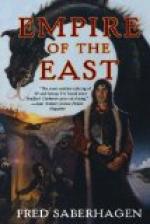But our worthy host armed himself with a big stick, and we sallied forth again under his guidance. Even then it was no joke, and the house of Dr. S. came as a haven of refuge. Anyone who has been in the East knows what an amount of persistency and endurance the Oriental beggar possesses.
[Illustration: THE RIBNICA]
We were received as old friends and welcomed to the Easter table, which was set, as in any other Montenegrin house at this season, for anyone and everyone who has the remotest claims of acquaintanceship.
Several men were present, to whom we were at once introduced; amongst others a canny Scotchman, the only Britisher living permanently in the country. We were a cosmopolitan gathering. There was Dr. S., a Roumanian, an Austrian ornithologist, a Scotchman, our innkeeper was a Macedonian, and two or three Montenegrins. From that evening date many of the pleasant friendships which we made in Montenegro.
The next day our newly-made friends showed us Podgorica. It is divided into two distinct parts—the old, or Turkish town, and the new Montenegrin town, which dates from the conquest of 1877. The two halves are separated by the River Ribnica, which flows in a deep bed before the crumbling walls of the Turkish quarter. At one angle of the town the Ribnica enters the Moraca, Montenegro’s biggest and most important river.
Most picturesque is the old Turkish quarter, still surrounded by the same bastions and walls which not so long ago defied the Montenegrin army. But the houses, as well as the walls, are fast falling to ruin; for at the order of the Prince the market has been removed to the other side, and, in comparison with the new town, there are few inhabitants left. The fortifications still bear witness to the fierce struggle which took place before them, and one bastion was breached more successfully than ever Montenegrin cannon had done, by lightning, during the bombardment. Many of the older inhabitants, as well as the walls, show traces of the former conflict, a noseless man being no great curiosity.
Not for nothing has the Montenegrin won his fame as one of the fiercest fighters in the world. He was never outdone in atrocities by his enemies. It was the rule of war (and is now, to a great extent) to either behead one’s prisoner on the spot, or, if the day had been exceptionally heavy, and more heads could not be carried conveniently, noses were taken instead. Perhaps the phrase “to count noses” originated in these lands. However, it usually ended the same, for the noseless man would, as a rule, bleed to death; but some have lived through it, and can be met with anywhere in Montenegro or Albania.
Many fierce fights took place in and about Podgorica, and the ghastly picture of victorious Montenegrins at the conclusion of an affray, sitting in groups, each with a small or large heap of heads and noses before him, “counting the bag,” has many eye-witnesses still living.




